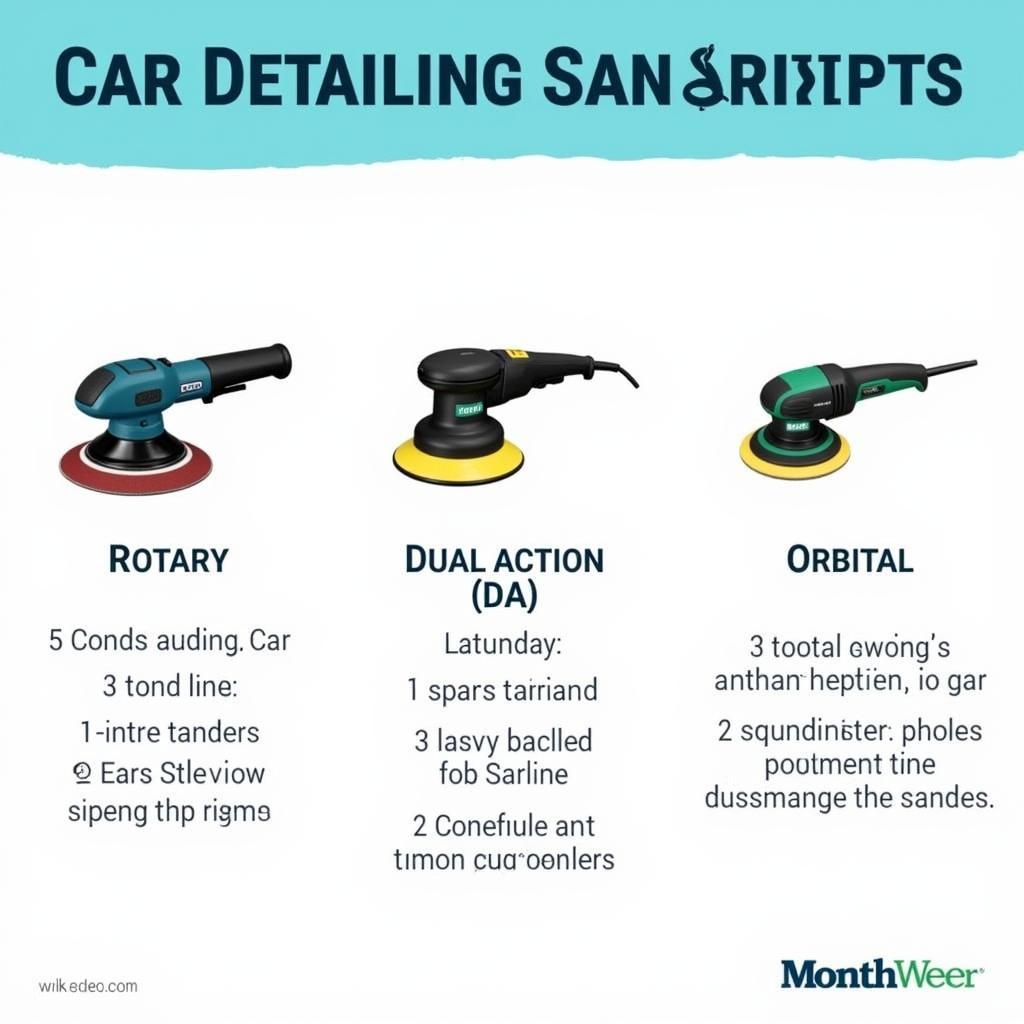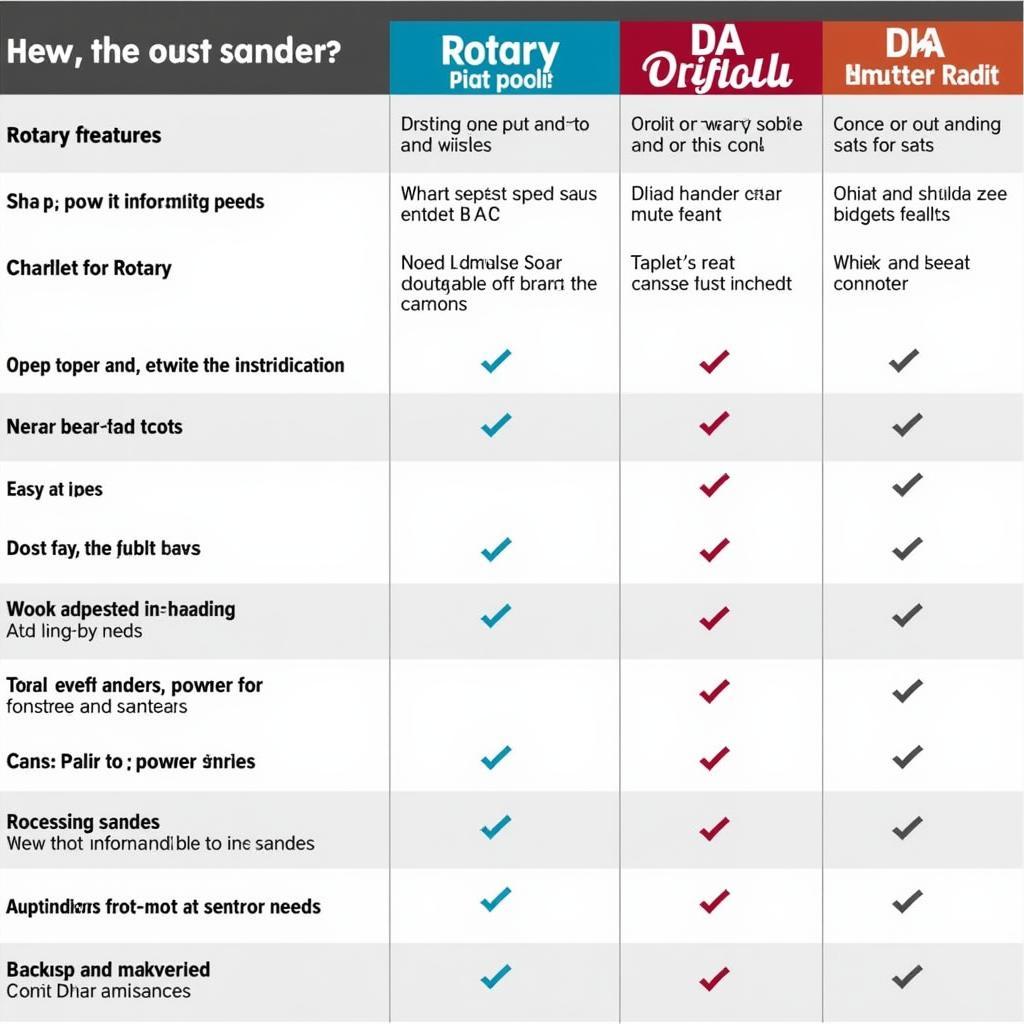Car Detailing Sanders are essential tools for achieving a flawless finish, whether you’re a professional detailer or a passionate car enthusiast. Choosing the right sander and using it correctly can dramatically improve the results of your detailing work, from paint correction to removing scratches and swirl marks. This guide will explore everything you need to know about car detailing sanders, helping you make informed decisions and achieve professional-level results.
Types of Car Detailing Sanders
Different types of car detailing sanders cater to various needs and skill levels. Understanding the strengths and weaknesses of each type is crucial for selecting the right tool for the job.
Rotary Sanders
Rotary sanders are powerful tools capable of aggressive cutting and rapid material removal. They are ideal for experienced detailers tackling heavy paint correction, but their high speed and rotational motion require careful control to avoid damaging the paint.
Dual-Action (DA) Sanders
Dual-action sanders, often referred to as DA sanders, offer a balance between power and control. Their orbital and rotational motion minimizes the risk of burning through the paint, making them suitable for both beginners and experienced detailers. DA sanders are versatile and can be used for various tasks, including polishing and waxing.
Orbital Sanders
Orbital sanders move in a random orbital pattern, providing a swirl-free finish. They are gentler than rotary sanders, making them perfect for final polishing stages and applying wax or sealant. While they might not be as powerful as rotary or DA sanders, they offer exceptional control and minimize the risk of paint damage.
 Different Types of Car Detailing Sanders
Different Types of Car Detailing Sanders
Choosing the Right Sander for Your Needs
Selecting the right car detailing sander depends on several factors, including your skill level, the type of detailing work you’ll be performing, and your budget.
Skill Level
Beginners should opt for DA or orbital sanders, which offer greater control and minimize the risk of errors. Rotary sanders are best left to experienced detailers who understand how to control their power and avoid damaging the paint.
Detailing Tasks
For heavy paint correction and removing deep scratches, a rotary sander is the most efficient choice. DA sanders are versatile and can handle a range of tasks, from paint correction to polishing and waxing. Orbital sanders excel at final polishing and applying wax or sealant.
Budget
Car detailing sanders are available at various price points. While higher-end models often offer more features and durability, budget-friendly options can still provide excellent results for beginners or occasional use. Consider your budget and choose a sander that meets your needs and financial constraints.
 Comparing Car Detailing Sanders
Comparing Car Detailing Sanders
Using a Car Detailing Sander Effectively
Regardless of the type of sander you choose, using it correctly is essential for achieving optimal results and avoiding paint damage.
Proper Technique
Always start with a clean surface and use the appropriate sanding pad and polishing compound for the task at hand. Maintain even pressure and avoid applying too much force, which can lead to uneven sanding and paint damage. Work in small sections and overlap each pass to ensure a uniform finish.
Sanding Pads
Different sanding pads are designed for various stages of the detailing process. Aggressive cutting pads are used for heavy paint correction, while finishing pads are used for final polishing. Choose the right pad based on the severity of the imperfections and the desired finish. Remember to keep your pads clean and replace them when they become worn.
Polishing Compounds
Polishing compounds are abrasive materials that remove scratches and swirl marks from the paint. They are available in various grades, from coarse to fine. Start with a coarser compound for heavier correction and gradually move to finer compounds for polishing and refining the finish.
Conclusion
Choosing and using the right car detailing sander is crucial for achieving professional-level results. By understanding the different types of sanders, choosing the appropriate one for your needs, and using it correctly, you can transform your car’s appearance and protect its paint. Investing in a quality car detailing sander is an investment in the long-term beauty and value of your vehicle. Remember to always prioritize proper technique and use the appropriate sanding pads and polishing compounds to achieve a flawless finish.
FAQ
-
What type of sander is best for beginners? Dual-action (DA) or orbital sanders are recommended for beginners due to their ease of use and control.
-
Can I use a car detailing sander on all types of paint? While most car detailing sanders can be used on a variety of paint types, it’s important to test in an inconspicuous area first to ensure compatibility.
-
How often should I replace my sanding pads? Sanding pads should be replaced when they become worn or no longer provide effective cutting or polishing.
-
What is the difference between a polishing compound and a wax? Polishing compounds are abrasive and used to remove imperfections, while waxes are protective coatings that enhance shine and protect the paint.
-
Can I use a car detailing sander to remove deep scratches? Deep scratches may require professional attention, but a rotary sander can be effective for removing some deeper imperfections with proper technique and experience.
-
What safety precautions should I take when using a car detailing sander? Always wear safety glasses and a dust mask when using a car detailing sander. Ensure the work area is well-ventilated and the car’s surface is clean and dry.
-
How do I choose the right polishing compound for my car? The choice of polishing compound depends on the severity of the imperfections and the desired finish. Start with a coarser compound for heavier correction and gradually move to finer compounds for polishing.
For further information on car care, you might find our article on car detailing terrace helpful. It offers insights into creating the perfect environment for detailing your vehicle. This guide will also benefit those interested in learning more about car detailing terrace and how it complements the use of car detailing sanders.
If you need assistance, please contact us via WhatsApp: +1(641)206-8880 or Email: [email protected]. We have a 24/7 customer support team available to help.

Leave a Reply